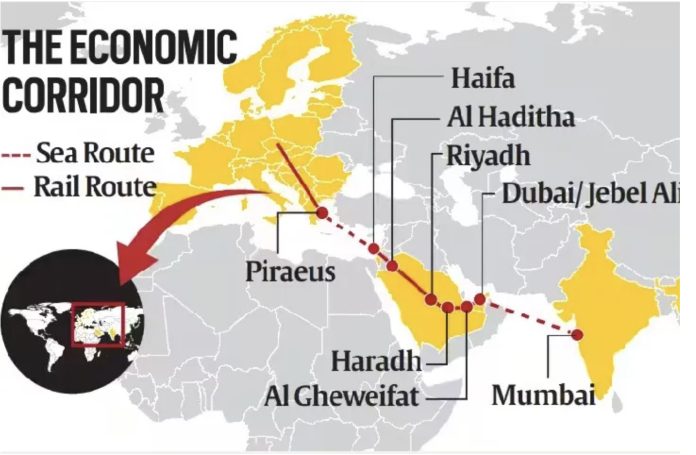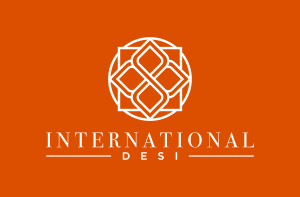𝐈𝐧𝐝𝐢𝐚, 𝐔𝐒, 𝐔𝐀𝐄, 𝐒𝐚𝐮𝐝𝐢 𝐀𝐫𝐚𝐛𝐢𝐚, 𝐅𝐫𝐚𝐧𝐜𝐞, 𝐆𝐞𝐫𝐦𝐚𝐧𝐲, 𝐈𝐭𝐚𝐥𝐲 𝐚𝐧𝐝 𝐭𝐡𝐞 𝐄𝐮𝐫𝐨𝐩𝐞𝐚𝐧 𝐔𝐧𝐢𝐨𝐧 𝐂𝐨𝐦𝐦𝐢𝐬𝐬𝐢𝐨𝐧 𝐡𝐚𝐯𝐞 𝐬𝐢𝐠𝐧𝐞𝐝 𝐚 𝐌𝐞𝐦𝐨𝐫𝐚𝐧𝐝𝐮𝐦 𝐨𝐟 𝐔𝐧𝐝𝐞𝐫𝐬𝐭𝐚𝐧𝐝𝐢𝐧𝐠 𝐭𝐨 𝐞𝐬𝐭𝐚𝐛𝐥𝐢𝐬𝐡 𝐭𝐡𝐞 𝐈𝐧𝐝𝐢𝐚-𝐌𝐢𝐝𝐝𝐥𝐞 𝐄𝐚𝐬𝐭-𝐄𝐮𝐫𝐨𝐩𝐞 𝐄𝐜𝐨𝐧𝐨𝐦𝐢𝐜 𝐂𝐨𝐫𝐫𝐢𝐝𝐨𝐫. 𝐓𝐡𝐢𝐬 𝐰𝐚𝐬 𝐚𝐧𝐧𝐨𝐮𝐧𝐜𝐞𝐝 𝐨𝐧 𝐒𝐚𝐭𝐮𝐫𝐝𝐚𝐲, 𝟖 𝐒𝐞𝐩𝐭𝐞𝐦𝐛𝐞𝐫, 𝐢𝐧 𝐃𝐞𝐥𝐡𝐢.
As a result, there will be enhanced connectivity and economic integration between Asia, West Asia/Middle East, and Europe, which will stimulate economic development.
As part of the IMCC EC, there will be two different corridors (i) East corridor connecting India to West Asia / Middle East, and (ii) Northern corridor connecting West Asia / Middle East to Europe. The project will include a new rail line that will enhance the transshipment of goods and services between South-East Asia through India to West Asia / Middle East and Europe as a reliable and cost-effective cross-border ship-to-rail transit network.
The connectivity with the countries of the region remains a key priority for India, which is deeply rooted in the history of Indian civilization. In accordance with the concept “One Earth, One Family, One Future”, India has always committed to investing, cooperating, and building connectivity.
The expansion of connectivity must be accompanied by transparent, consultative, and participatory initiatives. In order to maintain the sovereignty and territorial integrity of all countries, this must be done. It is imperative to adhere to principles of financial responsibility & economic viability to avoid unsustainable debt burdens for recipients.
In addition to providing our industry and business with new opportunities to enter international trade and logistics corridors, development cooperation aims to stand out as a symbol of an alternate approach.
As a result, India stands to gain significantly since it places it firmly on the route of trade flows from South East Asia to the Gulf, West Asia and Europe. In addition to creating huge opportunities in the logistics and transportation industries, this provides us with significant strategic and economic advantages.
In addition to boosting our trade and exports, it provides us with faster and more affordable transit options. This corridor can be developed as a green corridor. As a result, our green transition objectives will be enhanced, our regional standing strengthened, and our companies will be able to participate equally in infrastructure construction in the region. Along with securing supply chains, creating jobs, and improving trade facilitation, the corridor will also improve accessibility and facilitate trade.
In the areas of connectivity, logistics & freight infrastructure, clean energy & hydrogen production, and energy transmission infrastructure, the MoU will create opportunities for trade and economic cooperation between the parties.This project will improve the logistics and transportation infrastructure. In turn, it will enhance India’s self-reliance by developing significant capacities. Also, this aligns with path-breaking initiatives like Make in India, Sagarmala, and Atmanirbhar Bharat.




